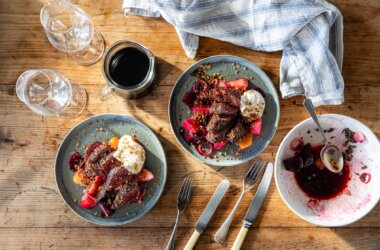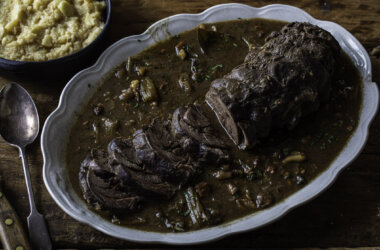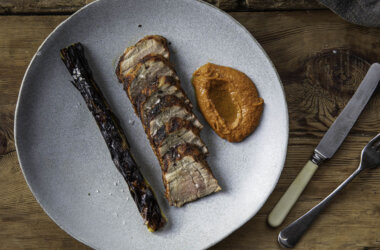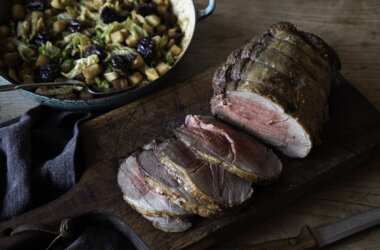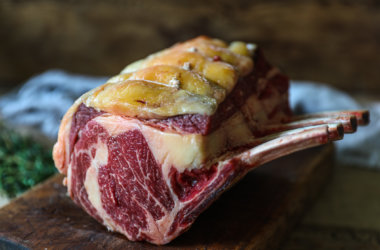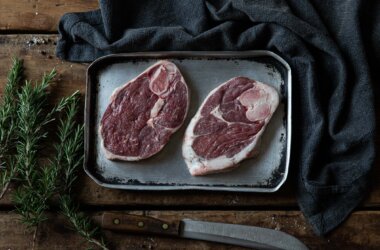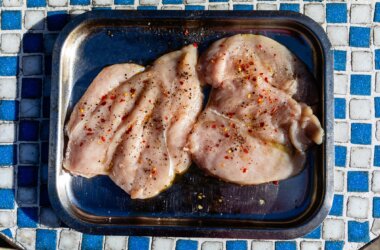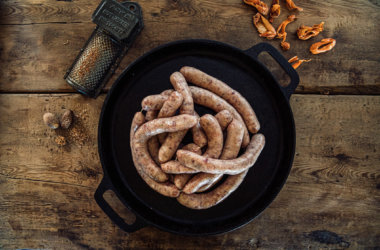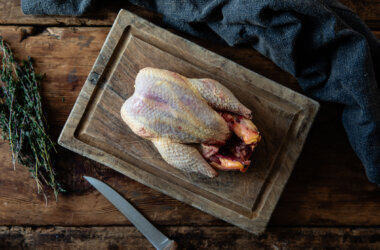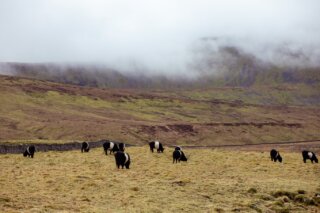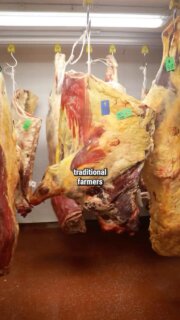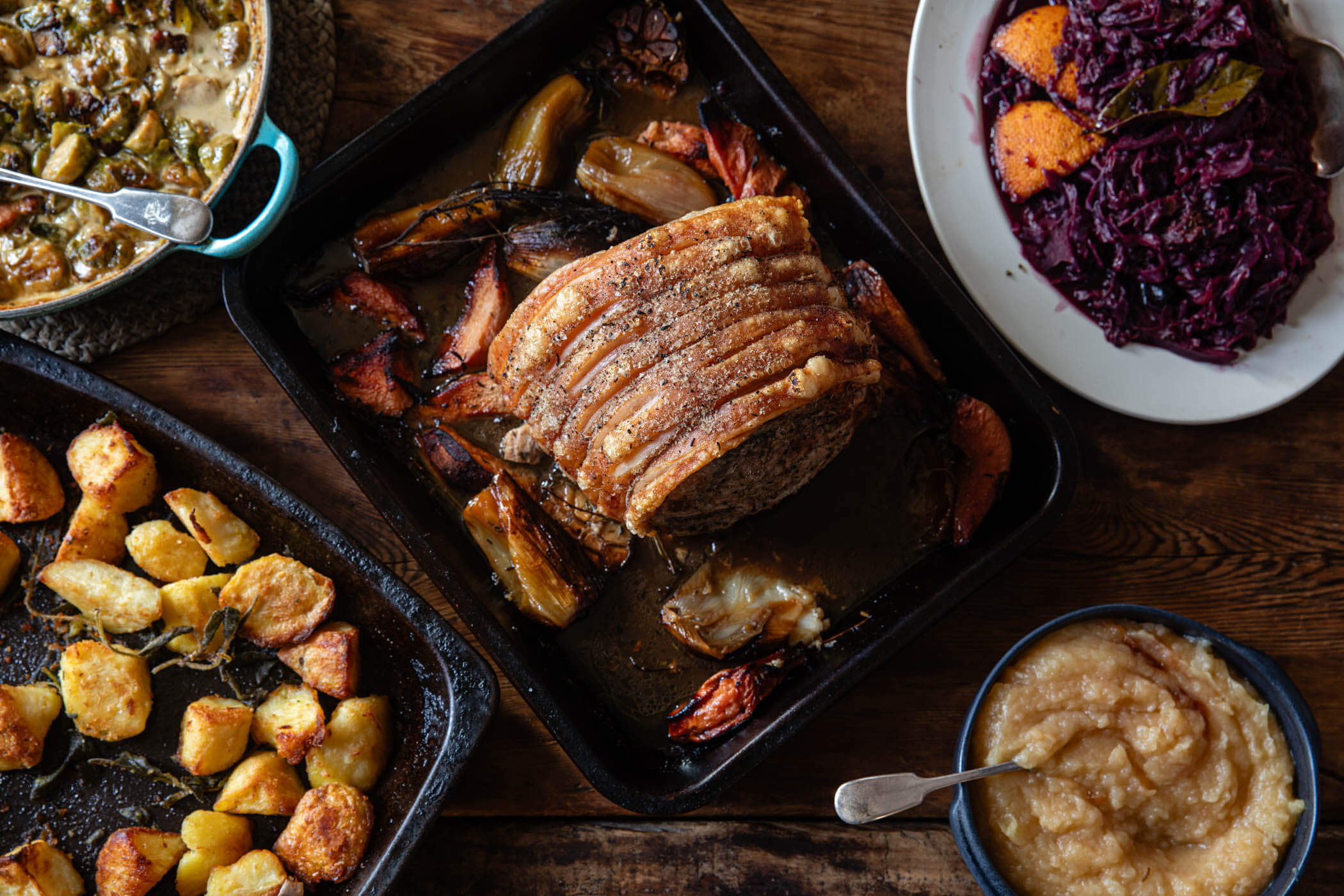
Roasted Pork Leg Recipe: Roasted Pork Leg with Quince, Braised Red Cabbage, and Creamed Sprouts: A feast of a meal, with a perfectly roasted joint of pork at its heart, this dish makes a fitting and delicious alternative to turkey for your Christmas dinner table.
While pork leg might not be the first choice that comes to mind for a celebratory meal, it deserves a place in the spotlight. With lean, flavourful meat, a generous cover of fat, and a rind that transforms into irresistible crackling, it’s a cut that shines when handled with care.
This roasted pork leg recipe was crafted with the festive season in mind, but its warming flavours and hearty accompaniments make it just as suitable throughout the winter months. If you’re looking to impress your guests with something a little different, this pork leg roast with quince, braised red cabbage, and creamed sprouts is a celebration-worthy centrepiece.
Serves: 10-12
Cook time: 4 hours
Ingredients
Red Cabbage
Creamed Sprouts
Roast Potatoes
Apple Sauce
For a slightly sweeter flavour, you can mix Bramley apples with a dessert variety such as Cox’s Orange Pippin or Braeburn.
Method
Preparing and Roasting the Pork
- Prepare the Seasoning: Place the black peppercorns and fennel seeds in a small dry pan over medium heat. Toast the spices for 3–4 minutes until fragrant. Transfer to a pestle and mortar and grind to a fine consistency. Add 2 tablespoons of sea salt and mix thoroughly.
- Season the Pork: Rub the prepared seasoning all over the pork leg joint. Leave the joint uncovered and out of the fridge for about 3 hours to come to room temperature.
- Prepare the Roasting Tray: Preheat your oven to 210°C. Arrange the quartered quinces, shallots, and sage in a large roasting tray, seasoning lightly with sea salt.
- Assemble the Dish: Drizzle a little olive oil over the pork leg joint and place it in the roasting tray, nestled among the quinces and shallots. Pour the cider and 200ml of chicken stock into the tray.
- Initial High-Heat Roast: Place the tray in the oven and roast for 15 minutes at 210°C to start developing crispy crackling.
- Lower Temperature for Slow Cooking: Reduce the oven temperature to 145°C and continue roasting for 2–2 ¼ hours, or until the internal temperature of the pork reads 54–56°C on a meat thermometer.
- Final High-Heat Blast: Remove the tray from the oven and increase the temperature to 220°C. Once preheated, return the tray to the oven for 10–12 minutes. This final step will crisp the crackling further and bring the internal temperature to 58–60°C.
- Rest the Pork: Remove the pork, quinces, and shallots from the tray. Rest the pork for at least 1 hour. During this time, the internal temperature will rise to the mid-60s, ideal for tender and juicy meat.
- Make the Gravy: Place the roasting tray over high heat and add 500ml of fresh chicken stock. Simmer gently, scraping the pan to release any caramelised bits, until the gravy thickens to a desirable consistency. The gravy should be rich, sweet, and infused with the essence of the roasted quinces.
- Serve: Carve the rested pork and serve with the roasted quinces, shallots, and a generous helping of gravy.
For the Red Cabbage
- Prepare the Cabbage: Remove any bruised outer leaves from the cabbage. Cut it into quarters and remove the root from the base. Coarsely shred the cabbage and place it in a large casserole dish. Season generously with sea salt and leave to sit for 15 minutes.
- Preheat the Oven: Set your oven to 150°C.
- Add Ingredients: Add all the remaining ingredients to the casserole. Using your hands, mix everything thoroughly to ensure the cabbage is evenly coated with the seasonings and liquids.
- Start Cooking: Place the casserole over medium heat and bring the mixture to a gentle simmer. Cover with a lid and transfer it to the preheated oven.
- Cook and Stir: Cook for 2 hours, stirring halfway through to ensure even cooking and to coat the cabbage in the juices.
- Finish and Adjust: After 2 hours, remove the casserole from the oven. Taste the red cabbage and adjust the seasoning if needed, adding more salt, sugar, or lemon juice to balance the flavours.
- Prepare in Advance (Optional): This dish can be prepared a day ahead, as the flavours often deepen and improve when left overnight. Simply reheat gently before serving.
For the Apple Sauce
- Brown the Butter: Place the butter and star anise in a suitably sized pan over medium heat. Cook until the butter just begins to brown, releasing a nutty aroma.
- Add the Ingredients: Add the apples, cider, sugar, and a pinch of salt to the pan. Stir everything together until well combined.
- Cook the Apples: Cover the pan with a lid and cook on medium heat for 6–7 minutes, allowing the apples to soften and release their juices.
- Rest the Sauce: Turn off the heat and leave the pan covered for 10 minutes. This resting time allows the flavours to meld and the apples to soften further.
- Stir and Adjust: Remove the lid, stir the mixture thoroughly, and check for seasoning. Adjust with more sugar, salt, or a squeeze of lemon juice if needed. If some of the apples at the bottom of the pan have caramelised, this adds a delicious depth of flavour – no need to worry.
- Serve: Serve the apple sauce warm as a perfect accompaniment to roast pork, or cool and store for later use.
For the Creamed Sprouts
- Blanch the Sprouts: Bring a large pan of well-salted water to the boil. Blanch the Brussels sprouts for about 4 minutes, then drain thoroughly in a colander.
- Cook the Lardons: Heat a wide, heavy-bottomed pan over medium heat. Add 1 tablespoon of olive oil, then the bacon lardons. Cook for about 8 minutes, stirring occasionally, until golden, caramelised, and swimming in their own fat.
- Sauté the Sprouts: Increase the heat to high and carefully add the blanched sprouts to the pan. Season with a pinch of salt, several grinds of black pepper, and a grating of nutmeg. Cook for 5 minutes over high heat, stirring regularly, until some of the sprouts pick up a light char.
- Add the Cream: Pour in the double cream along with a splash of water. Reduce the heat to low and simmer gently for another 5 minutes, allowing the flavours to meld.
- Bake in the Oven: Preheat your oven to 180°C. Transfer the pan to the oven and bake for 15 minutes until the cream thickens slightly and the sprouts are tender.
- Cool and Serve: Remove the pan from the oven and let it cool slightly before serving. These creamy, caramelised sprouts pair beautifully with roast pork or other hearty dishes.
For the Roast Potatoes
- Prepare the Potatoes: Place the peeled and chopped potatoes in a pot of cold water. Season generously with sea salt and set the pot over high heat with a lid on.
- Parboil the Potatoes: Once the water reaches a simmer, reduce the heat and cook the potatoes for 12–15 minutes, or until they are just tender.
- Cool the Potatoes: Drain the potatoes in a colander, then lay them flat on a tray to cool completely. This helps them dry out and creates a better surface for crisping.
- Preheat the Oven: Preheat the oven to 200°C.
- Heat the Fat: Divide the duck fat evenly between two large roasting trays and place them in the oven to heat for 10 minutes. The fat should be smoking hot before adding the potatoes.
- Coat the Potatoes: Carefully remove the trays from the oven. Divide the potatoes between the two trays, scattering the crushed garlic and sage leaves over the top. Turn the potatoes in the hot fat using a spatula to coat them evenly.
- Start Roasting: Return the trays to the oven and reduce the temperature to 180°C. Roast for 12 minutes.
- Turn and Roast Again: Remove the trays from the oven and use a spatula to turn the potatoes. Roast for another 12 minutes. Repeat this step twice more, turning the potatoes each time to ensure even browning and crispness.
- Drain Excess Fat: Once the potatoes are golden brown and crispy, remove the trays from the oven and carefully drain off any excess fat.
- Serve: Serve the roast potatoes hot, with their crispy exterior and fluffy interior making them the perfect side dish.
